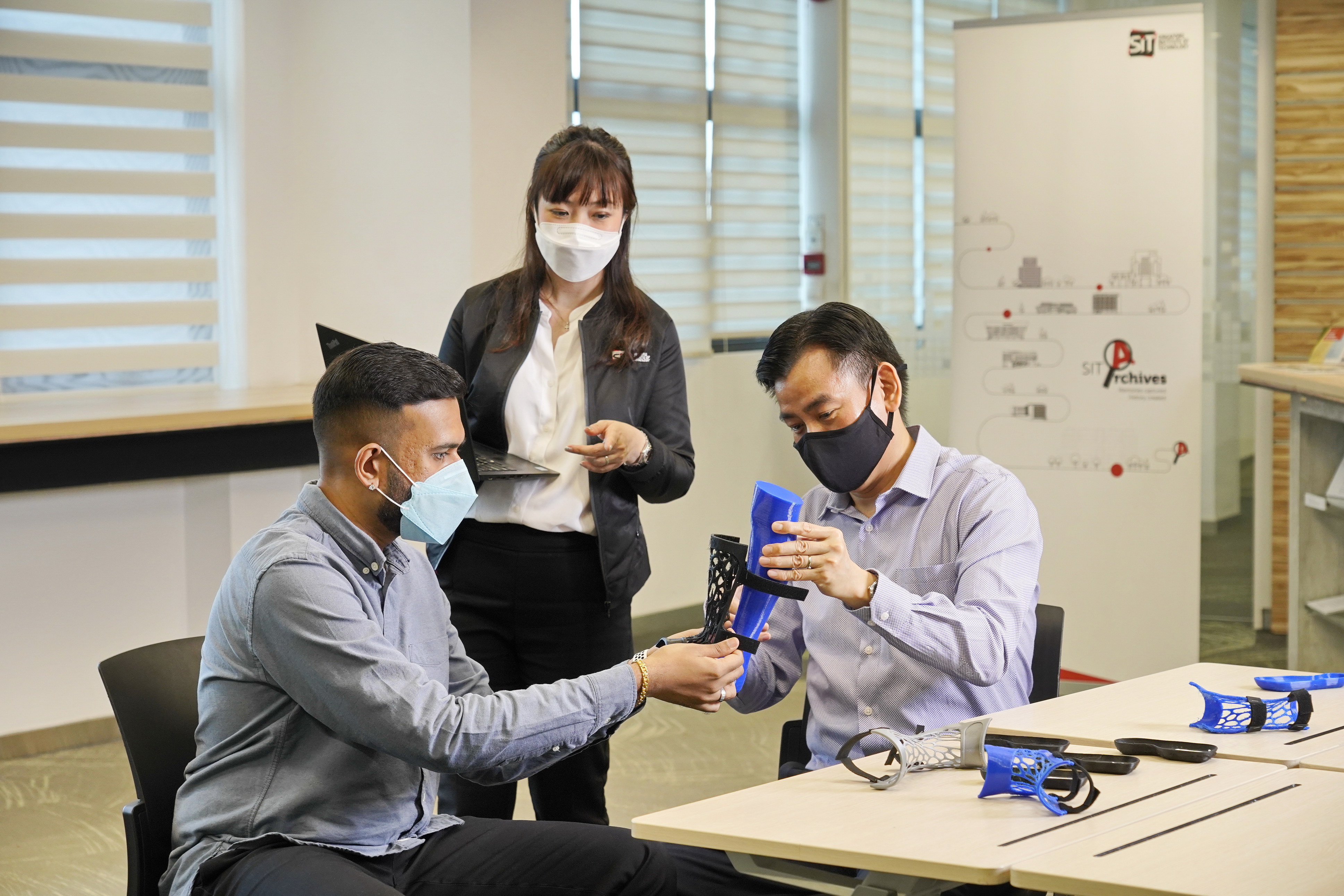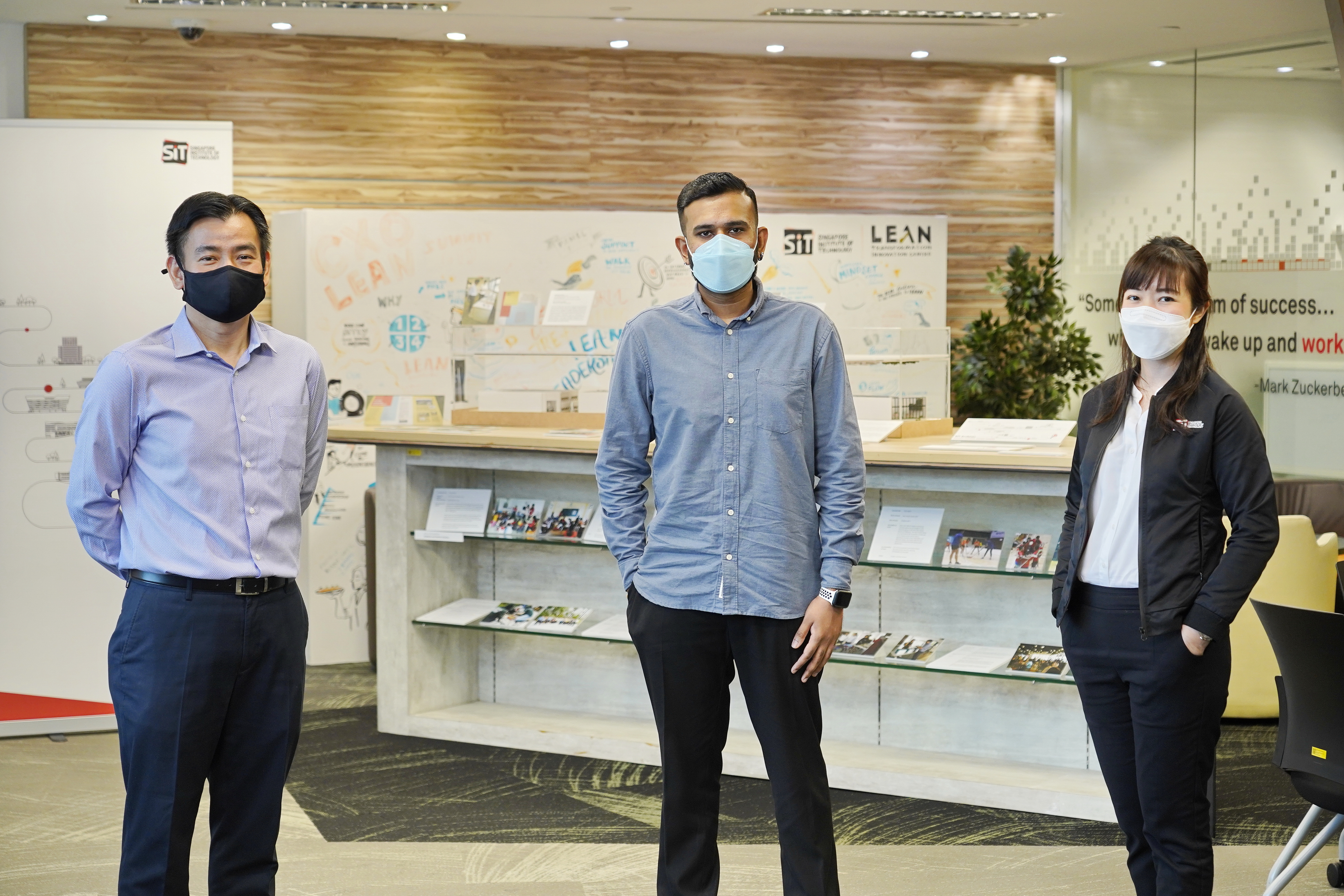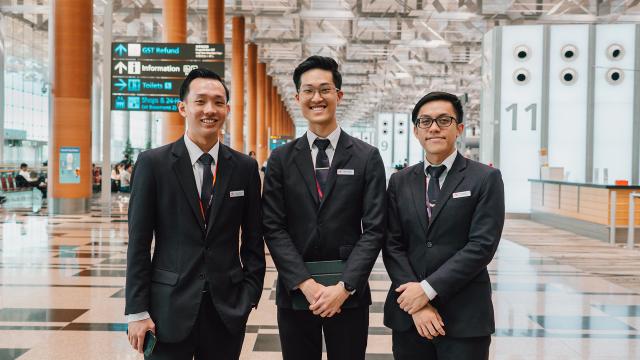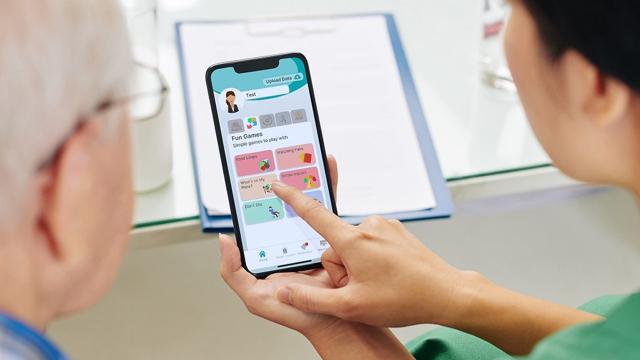
Suresh Krishnan, a Year 3 Mechanical Design and Manufacturing Engineering student, A/Prof Agnes Xue, Director, Design Factory@SIT and A/Prof Desmond Chong, Engineering, working on a prototype for HEALS
Suresh Krishnan pores over a set of designs splashed across his laptop screen. He makes quick calculations and adjusts the dimensions accordingly. After consulting his clinical partners and faculty advisors, they agree that several other modifications are required.
The Year 3 Mechanical Design and Manufacturing Engineering (MDME) student is working with a multidisciplinary team to fabricate an innovative ankle brace prototype that will help those with foot and ankle injuries recover better. The team comprises Singapore Institute of Technology (SIT) students and professors, as well as clinicians and medical students from partner SingHealth-Duke NUS Academic Medicine Innovation Institute (AMII).
This university-industry collaboration is the brainchild of Design Factory@SIT (DF@SIT), which moves small-and-medium-sized enterprises (SMEs) and government agencies up the innovation value chain through a multidisciplinary approach. It also allows academic staff and students to get up to speed with industry-specific needs.
“Having discussions with (industry partners) helped me shape my thought process better and taught me to look at problem statements from different perspectives,” said Suresh.
Through design thinking projects, DF@SIT enables companies to pilot ideas and build roadmaps with innovation tools, while offering applied learning and real work opportunities for students.
Moving up the innovation value chain
DF@SIT is a member of the Design Factory Global Network, a hub of 33 members spanning five continents, that was conceived in Finland’s Aalto University. Each city’s Design Factory empowers its unique business ecosystem around it.
The centre in SIT was launched in April this year with a focus to help companies, especially local SMEs, move up the innovation value chain. This begins with growth conceptualisation, to shaping a customised plan for the best results, before executing the plan in stages.
Its mission is to use design tools to foster a vibrant marketplace underscored by three prongs: innovation, talent, and network.
Headed by Associate Professor Agnes Xue, the team comprises three core members who are academic staff, and a pool of external coaches. “We look at our clients’ pain points and mentor them on how they can do better to transform and create value,” she said.
For example, companies that are eager to innovate can get in touch with DF@SIT for support. A/Prof Xue and her team will introduce design tools, such as concept screening and methods to de-risk their proposals, to help them better visualise how to execute their plan.
It is a dynamic process. There is no one-size-fits-all approach as different clients have different needs. DF@SIT provides a slew of options, including three-year collaboration agreements or a one to three-day co-creation programme for local firms.
“Some companies have something in mind for things that are three to five years down the road, so we’ll propose to go into a more comprehensive collaboration and come up with a plan for them to get there,” explained A/Prof Xue, “Our role is to help people ask the right questions and ask the questions right.”
DF@SIT also aims to build a network of innovation nodes by bringing together businesses and institutions in Asia. Through this process, not only will partners be able to utilise SIT’s resources and capabilities to progress, students will also get a taste of the workplace experience.
Students are more than just the supporting cast
One such collaboration is HEALS, the ankle brace project that Suresh is working on.
Foot and ankle injuries are among the most common injuries seen in hospitals, and often result in significant healthcare spending. Yet, current treatments have several drawbacks such as skin complications, stiffness, and discomfort.
HEALS provides a timely solution that combines immobilisation and cryotherapy seamlessly into rehabilitation, according to A/Prof Desmond Chong, who is overseeing the project together with A/Prof Xue. “It has the potential to reduce the rate of immobilisation-related complications and improve patient satisfaction.”
“The team is integrating two crucial procedures into one medical device for the benefit of the patients, and this also shortens the clinical hours of the healthcare providers,” he said, adding that a commercial product could be launched in one to two years.
SIT undergraduates are not just there to put on their thinking caps for real industry problems – they also help the company gain new insights.
“Students always come with an open mind in university-industry collaborations, and are able to identify blind spots which the professionals may miss,” said A/Prof Chong. “Being innovative is a key element of problem-solving.”
Creating an affordable, comfortable, and ergonomic ankle brace is right up Suresh’s alley. Countless hours of tinkering with engineering design projects in school gave him the confidence to brainstorm ideas alongside experts.
He considers his time with DF@SIT a more peer-to-peer experience rather than a supervised one, and has developed more than just industry know-how.
“I’ve come to appreciate and learn the expectations of real applications,” he said. “This experience has also cultivated my leadership ability and professionalism as I was given several responsibilities to execute the necessary tasks.”

The SIT team behind HEALS - A/Prof Desmond Chong, Engineering; Suresh Krishnan, a Year 3 Mechanical Design and Manufacturing Engineering student; A/Prof Agnes Xue, Director, Design Factory@SIT. DF@SIT works with students and faculty across SIT’s different clusters on industry and applied research projects.
![[FA] SIT One SITizen Alumni Initiative_Web banner_1244px x 688px.jpg](/sites/default/files/2024-12/%5BFA%5D%20%20SIT%20One%20SITizen%20Alumni%20Initiative_Web%20banner_1244px%20x%20688px.jpg)


